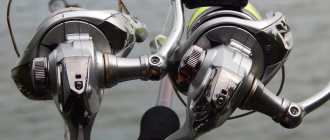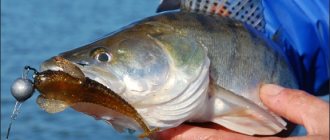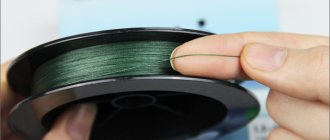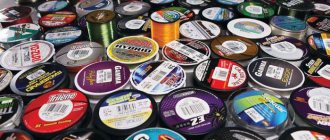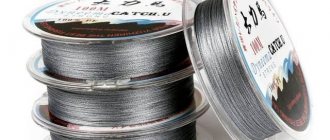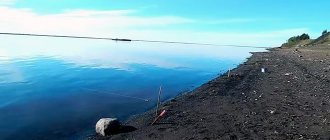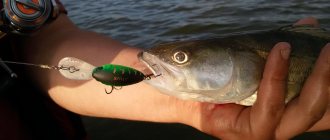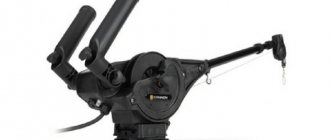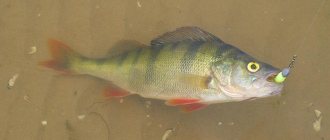Four-core or eight-core cord, which is better for jig?
Advantages of a four-core cord:
- Lower price;
- It withstands aggressive environments very well (sharp stones, shell rock, glass, etc.);
Flaws:
- The noise made by the cord as it rubs against the rings as it is pulled out. The thicker the cord, the louder the sound. The reason is that the structure of a 4-core cord is less uniform than an 8-core cord, which leads to the following disadvantage.
- Shorter casting distance - if you purchase two cords from the same manufacturer, of the same thickness and made of the same material, then the 8-strand cord will fly further.
- There is a lot of windage in the air and water, which is why when fishing in currents and side winds, the sensitivity of the gear is reduced, which means we can miss careful bites. We also don’t feel the bottom so well, which is important when jig fishing.
- When fishing in sub-zero weather, the 4-core cord will freeze more strongly.
Advantages of an 8-core jig cord:
- It has a more rounded cross-section, which allows you to throw further, and does not hurt your ears as much when reeling in the tackle.
- If you use a high-quality eight-strand fishing line, then the fiber structure absorbs much less water with various microparticles of sand, clay, etc., due to which the cord lives longer and damages the rings less. Also, it freezes over significantly less than 4 veins at sub-zero temperatures.
- The most important advantage of the 8-core cord is its high sensitivity. Since 8-core cords stretch less than 4-core cords and their sensitivity is higher.
Disadvantage of an eight-core cord
- High price. So an 8-core cord of the same manufacturer, diameter and material, can cost 50-60 percent more than a 4-core one.
- 8-core cords have low resistance to the effects of aggressive bottom. This is only partly true, since previously there were a lot of 8-cores on sale, designed not for jig fishing, but, for example, for sea fishing in a vertical line, while fishermen unknowingly wound them on reels and caught them on steep edges and shell rocks. Naturally, the braid was torn, and the fishermen spat.
- Now, more and more braids are being imported, designed specifically for fishing in an aggressive environment. And if you have 4 strands that work well on shell rock, then by purchasing 8 strands from the same manufacturer, made from the same material, you will get the same stable cord.
- Knots that work well with 4-strand braids may not work with 8-strand braids due to their lower roughness. In this case, they often have to be modified, increasing the number of turns, otherwise when the knot is tightened, the line simply slips and it comes undone.
Of course, you can find three-core or twelve-core cords on the counter, but they are quite rare, so we didn’t touch on them.

Features of braided lines
Like any fishing product, braid has its own characteristics, consisting of a combination of advantages and disadvantages. The braid has the following advantages:
- Low almost zero elongation, providing high sensitivity.
- High strength with low thickness, which allows you to make long casts, use light baits and fish in windy weather.
- Resistance to external factors such as ultraviolet radiation, temperature changes, etc.
- Lack of memory.
- Durability.
At the same time, braiding is not without its drawbacks, the main ones being:
- Low abrasion resistance.
- The ability to absorb water and along with it abrasive particles that negatively affect individual elements of spinning tackle.
- Tendency to freeze at negative air temperatures.
- Relatively high cost.
Despite all the shortcomings, in most cases, fishing without braid, especially jig fishing, turns into an unpromising activity.
What length of cord should I buy?
On sale you can find reels with cord in unwinding lengths of 100 m, 120, 150, 200 m, etc. Which one is worth taking? This choice depends on several factors:
The first is the line capacity of the spool on your reel. As a rule, there is a marking on the side that tells us how many meters of cord of a given diameter we can wind on a given reel. Therefore, if the reel holds 150 meters of fishing line, it is stupid to take a 200 m long unwind.
Some stores have unwinders of 2000 meters. Which is very convenient for those who have reels from unknown manufacturers, without markings regarding the amount of line they can hold. Fishermen come to the store and the sellers wind them with fishing line from these reels until it stops, after which they pay for the amount of fishing line wound.
Second is the budget. It is important to understand the price of each meter. So, for example, there is a jig line 150 m long, which sells for 1000 rubles and exactly the same, but 300 m long and priced at 1700 rubles. 300 meters are more expensive, but if you count the price per meter, it turns out cheaper. Another point, for example, your reel holds 250 m, but in order to save money, you buy 120 m, you fish, the gear breaks three times, and you have 50 m of line left, but you need to cast at 60 m, which means you throw away the line and buy a new one. Then you fish again and breaks occur again, so you have less than 60 m left, you throw away this section again, but in total you have already thrown away 100 m of fishing line. And if you reeled in 240 m at once, you would only throw out 50 m. If the line shows good wear resistance, then the remaining meters can be used as a shock leader for the feeder.
Spinning
You need to be especially careful when choosing a spinning rod.
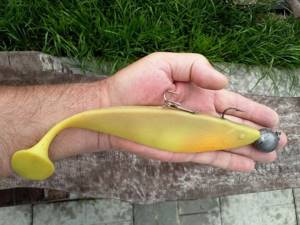
Fishing with a heavy jig involves moving a heavy bait in steps, often over a long distance and in depth. It is extremely important to feel the bait fall to the bottom, just as you should not lose contact with the bait.
That is, the first feature of a jig spinning rod is sensitivity.
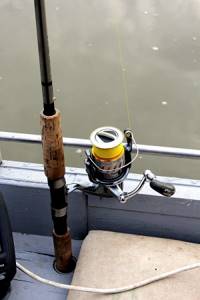
It’s a little simpler here than in choosing “light” gear. With significant weights, the sensitivity of the rod will be sufficient.
The best accessories for making heavy jig tackle, recognized all over the world, are from Fuji. Gorgeous, very reliable rings and reel holders.
In addition to sensitivity, you need to pay attention to the structure of the form.
It is customary to divide action into four types based on the dynamic bending of the rod.
- Very fast (EXTRA FAST. EF)
- Fast(FAST/F)
- Medium (MODERATE. M)
- Slow (SLOW.S)
Of course, for a heavy jig, as well as for any jig, a conical action rod (EXTRA FAST and FAST), which has another name in fishing slang - “evil stick”, is better suited. Range and accuracy, sensitivity when biting, and also, importantly, the effectiveness of hooking depend on the action.
A good rod will allow you to successfully not only reliably hook a predator, but also tie it up when fishing.
A test is a characteristic of a rod that indicates the weight range of the bait for which the blank is designed. Test for recommended lure weights, expressed in grams, pounds (lb) or ounces (oz).
English weights and measures, when converted into our usual system of measurements - 1 pound (lb) is equal to 454 grams, 1 ounce is approximately equal to 28 grams.
When choosing a spinning rod for heavy jig, you should pay attention to a weight of at least 20 grams. For example, 20-56, “two-pounder”. But for channel fishing with heavy baits, it is advisable to choose a spinning rod with a top weight of more than 100 grams.

A test indicated for rods in grams, for example 20-56 g, means that the spinning rod is designed for casting baits weighing from 20 to 56 g. If the weight is less than the minimum, then sensitivity when posting is not guaranteed. If the weight is exceeded, there is a risk of gear failure due to increased loads.
The fishing line test is desirable from 20 libra, libra (from Latin) lb is a unit of weight, equal to a pound, 1 pound is equal to 0.453 kg. 20 libra - approximately 10 kg. This characteristic of the form is very relative and should not be taken literally. All figures indicated are approximate and depend on many factors.
I did not mention the length of the spinning rod; the acceptable length depends on where you are going to fish.
The length of the spinning rod is specified in meters (m) or feet and inches, which are designated respectively: “ft” or “`” are feet, and ““” are inches. 1 foot is approximately 30.5 cm, and 1 inch is 2.54 cm. For example, the marking 8'6″ is equal to 2.59 m.
From the shore, the acceptable length is 2.7 meters. It is comfortable to fish from a boat with shorter spinning rods. The choice is yours.
When choosing gear for heavy jigs, it is advisable to give preference to famous brands. I prefer American spinning rods, which, in my opinion, although they are “tailored” for catching steelhead salmon, but again, purely my opinion, are the most suitable for jigging. They rightfully boast technical characteristics and power reserves. Famous American brands: Lamiglas. Talon. St. Croix. G. Loomis.
Japanese leading manufacturers are constantly coming up with new production technologies and new materials. Among the Japanese brands you should pay attention to: Graphite leader. Major Craft. Daiko.
Koreans tend to copy Japanese and American spinning rods. Modern materials and technologies, build quality and price serve as an advantage for the Koreans. Such as Black Hole. Aiko. Maximus and of course Banax
Diameter and breaking load

Cord size marking
Things are pretty confusing here. For example, Chinese, European and some American manufacturers indicate the diameter of the cord in millimeters or inches. Moreover, the diameter of the braid is indicated very approximately, since the cord, unlike monofilament, is not uniform, and its cross-section can be oval or flattened.
The Japanese indicate thickness in their units, which can be seen next to the hash icon #. The thickness of Japanese braid can be in the range between 0.2 – 3.1, the higher the number, the thicker and stronger the cord. Moreover, from different Japanese manufacturers, cords with the same marking, for example # 1.2, can have different thicknesses and strengths. Size #1 approximately corresponds to a diameter of 0.15-17mm.
Reels from other manufacturers may indicate the thickness of the braid or its breaking load, which is indicated in kilograms or LB (libr), which often have the same value.
Choosing cord thickness
- If you fish with micro jigs using baits weighing up to 8 grams, then these are lines #0.3-0.4 according to Japanese numbering.
- For light tackle with sinkers weighing 8-22 grams, the cord is taken with a thickness of #0.6-0.8.
- When fishing with heavy jig heads, we use braided line # 1.0 -2.0, depending on the weight of the sinker and the size of the fish. If you take a cord that is too thin, then when casting, the bait may be shot.
If we talk about the Americans, then for light fishing cords of 0.06-0.1 mm are sufficient, and then we thicken them depending on the weight of the sinker.
It is also worth taking into account the fishing conditions, for example, when fishing from the shore, the cord is in more contact with the bottom and is deformed, losing strength, so here you can overestimate the thickness, and when fishing from a boat, on the contrary, it touches the bottom at a smaller angle and therefore wears out less.
Very often, when purchasing Japanese fishing lines, the breaking load indicated on the packaging is 30-40 percent higher than the real one. The point here is that the Japanese indicate the breaking load for a fishing line placed in ideal conditions - there is no knot on it, and it has never rubbed against shells or stones.
Diameter
Frankly speaking, cord diameter is a very relative concept . This is clear already from considering the technology of weaving cords. Manufacturers always indicate this characteristic on the reels. Americans traditionally do this in millimeters. Sometimes the Japanese do this too.
When comparing cords from different brands, it is striking that with the same breaking load, the diameter can differ significantly and vice versa. Therefore, the value of the maximum breaking load is still a more correct criterion when choosing a cord for jig.
The Japanese express the diameter of the cord in conventional units - #1 , #1.2 , #0.4 , etc. If desired, these values can be identified with a diameter in millimeters (cord #1 approximately corresponds to a thickness of 0.17 mm), but this is not what they are used for. These values help determine how thicker and stronger a cord of one diameter is than another. All this, of course, applies only to conscientious manufacturers.
Cord Budget
If you are a beginner angler, then there is no point in buying expensive cords; you can start with relatively cheap Select Basic PE . Then, having understood for yourself whether jig fishing is interesting to you, switch to lines from Japanese manufacturers. For amateur fishing, very expensive gear is not needed. But if you see yourself in the sport of fishing, then you will have to purchase a high-quality Japanese cord that will allow you to cast further, will be very informative and strong, giving you the opportunity to force the fish. At the same time, the price of such cords is high and will seem wasteful for amateur fishing.
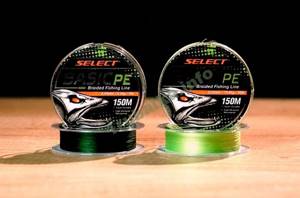
When buying a cord, you should be wary of counterfeits; popular models are most often counterfeited. A counterfeit can be revealed by the price, lack of quality packaging, or incorrect labeling. It is advisable to buy the cord in trusted stores that try to value their reputation and not purchase braided wire from Ali Express, since the Chinese often sell fakes.
Basic selection rules
When choosing a braid, you can be guided by the following rules:
- Buy cords from well-known, trusted brands , and not necessarily expensive ones.
- Choose cords based on the advice of experienced anglers and positive reviews on fishing forums. Usually there is quite a heated discussion of any fishing products and you can always get useful information.
- Do not buy Chinese counterfeits of well-known brands. It is not at all necessary that the cord purchased on Ali Express will be worthless, but almost certainly its characteristics will not correspond to those indicated on the package.
Jig line color
Brightly colored cords are needed when you are fishing with light weights and you cannot use the tip of the rod to determine the moment the sinker falls to the bottom.
Very often this happens when fishing for passive fish, when you have to set bait according to the lower test of the rod, for example, test a blank of 5-20 grams and you hook a sinker weighing 5 grams. As a result, you have to look at the line and determine by its sag when the sinker falls to the bottom. If you have a dark cord, your eyes may get tired quickly, especially in the evening or at night.
Advantages of braid for spinning rods. Which is better
Over the past ten years, braided lines have almost completely replaced the previously common monofilament lines from the spinning industry. This is not surprising in the development of spinning, since braid brought additional opportunities to this method of fishing, allowing fishermen to more effectively catch predatory fish using new baits and methods.
Modern multi-filament cord has the following advantages:
- Almost complete absence of stretchability, which greatly increases the sensitivity of the gear.
- High strength compared to monofilament line of the same diameter.
- Increased abrasion and wear resistance.
- Better flight.
- High reliability overall.
And here's what you need to know: Fishing for carp with a float rod: how to do it correctly?
Thanks to cords, such fishing methods as jig, twitching, jerking and others, where the inextensibility of the line plays an important role, have received tremendous development. Braid made it possible to fish more effectively with silicone and bulky plastic baits.
It was also useful in ultralight, especially in microjig, where without sensitive non-stretchable braid it is almost impossible to carry out the correct wiring and notice the fish biting.
Some features of choosing a braided cord
For coastal fishing with light tackle, it is better to use an 8-core cord of bright colors, with a spool of 200 or more, since we will cast far and breakage cannot be avoided. When light fishing, it is advisable to use thin lines 0.3-0.6, according to Japanese numbering.
Shore jig 15-35 grams, both 8-core and 4-core braids are used in unwinding 200+, color is no longer important, since the need for line control is much less frequent than when fishing with light tackle. Numbers 0.8-1.0 according to Japanese classification.
For boat fishing - eight-core cord 0.8 -1.2 according to Japanese numbering and unwinding 120-150 m. Longer cords are not needed when fishing from a boat.
Choosing a jig line

For lovers of jig fishing, the sensitivity of the gear is very important. On such fishing trips they take with them “ringing”, “dry” rods with a good sensitive or informative tip. But no matter how good the rod is, without a high-quality cord there will be no excellent sensitivity. A line for an angler who fishes with a jig is like wings for a bird - they cannot exist without each other.
Cord selection
For comfortable jig fishing, you need a good braided cord, which must have certain characteristics. Based on personal experience, I made some conclusions for myself. The most important of them is that “braid” for a jig should not be expensive. Many will probably wonder why? The cord is a consumable item. During fishing, the bait passes through the bottom layer, and the cord often comes into contact with various bottom debris, snags, and stones. Most of it falls into disrepair; it should be trimmed to avoid breaks when fishing for large fish. With frequent fishing, about three spools are spent per season, and this can cost a lot of money when using expensive cords.
When choosing a jigging cord, I would advise you to pay attention to the following characteristics: breaking load, cord cross-section, breaking load at the knots, color fastness and wear resistance. I chose them not by chance, because they complement each other, and with high performance of each of them, the model of an ideal cord for jig is obtained. However, a cord that meets all these criteria is not so easy to find. This prompted me to test the cords.
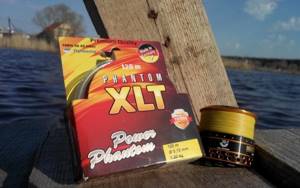
Currently, the fishing market has a huge selection of braided cords from various manufacturers, and many, especially beginners, simply don’t know which one to choose. Over 2 years of active jig fishing, I tried several different brands and models of cords in the price category up to 1200 rubles. To make the choice easier for anglers, I compared some of the ones I fished with. Each indicator is assessed on a five-point scale, where “5” is excellent, “4” is good, “3” is average, “2” is satisfactory and “1” is unsatisfactory. For comparison I chose the following cords:
Allvega Bullit Braid with a diameter of 0.12 mm according to the European classification;
Power Phantom XLT with a diameter of 0.12 mm according to the European classification;
Kashima GEN X4 #2.5 according to Japanese classification or 0.27 mm. according to the European classification.
Breaking load
Breaking load is one of the most important criteria when choosing a cord. But do all cords withstand the figure stated on the packaging? I checked this empirically using electronic scales. The cord was attached on one side to the loop of the scales, and on the other to the table leg. In both cases, I secured it with a knotless fastener, which allows one to obtain real indicators of the tensile strength of the cord. It must be said that during testing, not a single cord withstood 100% of the declared breaking load. The Power Phantom XLT, with a stated load of 9.2 kg, withstood only 7.5 kg, which is approximately 82% of the stated load. This cord received a score of 4 for this criterion. Allvega Bullit Braid, with a stated breaking load of 7.1 kg, withstood only 3.6 kg, which is 51%, so it received only 2 points. Kashima GEN X4 with a declared load of 11 kg withstood 8.1 kg, which is approximately 73% of the declared breaking load. For this indicator the cord received a rating of 4.
Cord diameter
Both for fishing with wobblers and for jigs, it is important to choose a cord that has the most round cross-section, since the casting distance of the bait, as well as the uniformity of its placement on the reel spool, largely depends on the cross-section of the cord. Among the tested cords, only two had a round cross-section - the Power Phantom XLT and Kashima GEN X4, for this criterion they received a score of 5. As for the Allvega Bullit Braid cord, its flatness is felt even to the touch, so it received only 3 points.
Breaking load of the cord at the nodes
Another important criterion for a cord is the breaking load at the nodes. In the first years of fishing with a spinning rod, out of inexperience, I tied the cord to the leash and baits at random, and, naturally, the breaking load on the knots was, to put it mildly, low. But nothing stands still, everything develops and improves, including skills, dexterity, and professionalism. I measured the breaking load on the nodes using three types of nodes: Palomar, Clinch and Uni. I compared it not with the declared breaking load, but with the real one, which I had measured earlier. Then he calculated the average breaking load on nodes of three types. The results were as follows: Power Phantom XLT withstood 85% of 7.5 kg. Excellent result, rating 5. Allvega Bullit Braid withstood 66% of 3.6 kg. The average result, respectively, is a rating of 3. Kashima GEN X4 withstood 74% of 8.1 kg. Good result, rating 4.
Color fastness.
I have noticed that line color is important to many anglers. I want it to be bright and make it easier to visually control the bait. Jig line should be bright, but do all lines retain color well? This is far from true. Some lines begin to lighten after two or three fishing trips, and after five or six they become pale. The only cord from the tested list was the Allvega Bullit Braid, which received a rating of 3 for this criterion. The PowerPhantom XLT cord showed a more worthy result. Only after five to seven fishing trips did it begin to lose color a little, for which it received a rating of 4. The winner in this category was the Kashima GEN X4 cord. After fishing with it on about ten fishing trips, I began to notice that it began to fade a little, although it belongs to the budget price segment. This is an excellent result, rating 5.
Wear resistance.
This criterion is very important when choosing a cord for a jig, since the working area often comes into contact with near-bottom objects and the bottom. It is especially offensive when, when biting a large fish, the “braid” breaks upon contact with snags or stones during fishing, and the trophy floats away; and you don’t even get to take a souvenir photo with him. Allvega Bullit Braid quickly begins to fray, and the working section of the line becomes unusable after the first fishing, so Bullit Braid received a rating of 3. Kashima GEN X4 is more suitable for fishing in “harsh” conditions, but does not reach the leader, so it received a rating of 4. Power Phantom XLT is the undisputed leader in this indicator; it is with it that I try to get out into snags in the reservoir, since snags do not pose a great danger to it. The maximum score for it is 5 points.
Conclusion.
Based on the scores for each indicator, we calculate the average score:
1st place goes to Power Phantom XLT, average rating 4.6 points.
2nd place goes to Kashima GEN X4, average score 4.2 points.
3rd place for Allvega Bullit Braid, average score 2.8 points.
I only talked about a small part of the cords in a certain price category, since these are the models I most often see on store shelves, which means they are also popular among amateur fishermen. Which cord to buy, is it worth spending a lot of money and what kind of cord should be used for jig - the choice is yours. Choose jig fishing, because in no other type of spinning fishing you will get a better understanding of the reservoir, the bottom topography, so many “evil” and loud bites, and do not forget about the right line.
Spirin Alexey
Video “Equipment for catching pike perch”
Let's look at the step-by-step improvement of jig equipment - from the simplest and roughest to the most promising and delicate.
- The simplest equipment is a direct attachment to the main line of a jig head with bait attached. Disadvantages: without a monofilament leash, the pike perch will be more wary of your bait, and at the moment of a dull hook, you will have to say goodbye, perhaps, to a large piece of expensive braid.
- A 1 meter long leash made of monofilament or fluorocarbon is attached to the main fishing line. The breaking load it can withstand should be 10-20% less than the main braid. It is advisable to check this manually, and not just trust the numbers on the reel.
- The third option is to equip the meter leash with a swivel with a clasp. This will allow you to quickly change the bait to the desired shape, color and size - thereby adapting to the fishing conditions.
